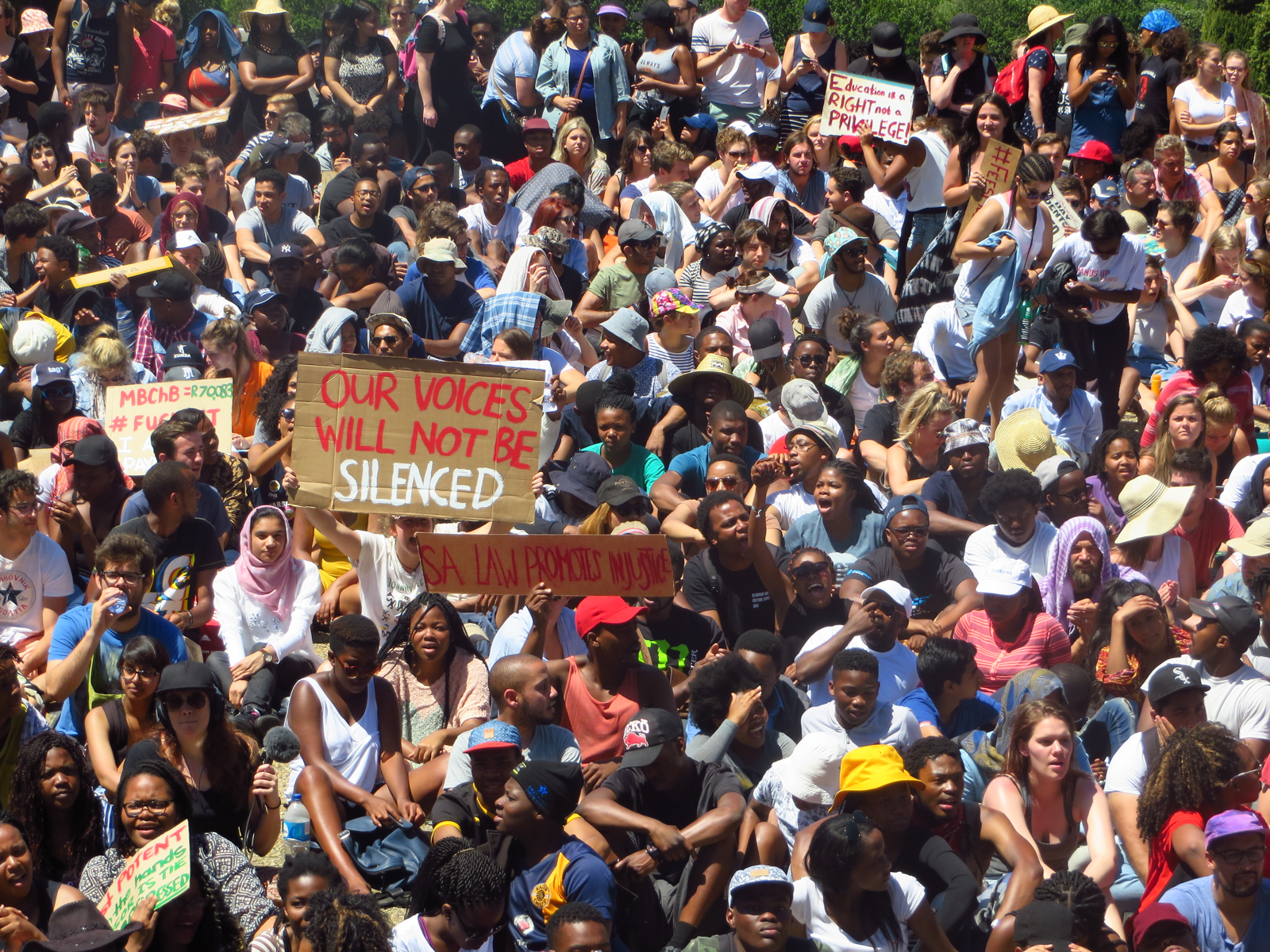Waves of protests on college campuses across the United States have opened urgent conversations about the presence of racism in higher educational institutions. This fall, students at various universities, including Yale, Missouri, and Brown, have come together to denounce the ways in which institutionalized racism continues to undermine the educational experience of minority groups. As students organize, a comparison with other student movements around the globe may serve as a point of reference and a source of inspiration for further action.
Just as in the United States, students in South Africa are protesting the unequal access to educational opportunities for historically marginalized communities. The apartheid logic of racial segregation spawned the designation of universities for particular racial groups up until 1994. Although universities have annulled such discriminatory policies, and students may attend any school regardless of their race, the regrouping of different racial communities in the university space has still failed to translate into a dissolution of racial tensions. Black students attending historically white-designated universities confront institutionalized racism on campuses. The post-apartheid era has bred a freer generation but has also posed new challenges of inclusion in a divided South Africa; in the face of persistent and pervasive racial tensions, students have taken the fight to tackle the remnants of apartheid to their universities.
New generation, new challenges
Students now attending university in South Africa are the first generation of college students who were born after the repeal of apartheid policies. Unlike their parents, they did not experience the legally enforced racial segregation that characterized most of South Africa’s modern history. While the legal framework supporting apartheid may have been dismantled before they were born, the legacies of apartheid can still be felt among young South African citizens. For the younger generations, oppression of marginalized groups persists through economic disparities and cultural divisions. Because racial segregation entailed unequal access to economic opportunities, Black citizens faced economic marginalization in addition to segregation during apartheid. As South Africa remains one of the most economically unequal countries in the world, overcoming racial inequalities seems a hard task without simultaneously addressing class marginalization. While the accomplishments of the older generation are not to be overlooked, university students today hope to live in a country more inclusive than the one even their parents envisioned by addressing both racial and economic inequalities in tandem.
The first wave in the most recent round of student protests began in April 2014, when students from the University of Cape Town demanded the removal of a statue of Cecil Rhodes, a British imperialist, which had been erected in recognition of his multiple donations to academic institutions in the region in the nineteenth century. Yet, as a bold supporter of British colonization of African territories and segregation policies, many students saw the statue as a symbol of oppression and effectively protested until its permanent removal.
Following the success of the protests at the University of Cape Town, in October, Black students took to the streets in Johannesburg and Pretoria railing against an increase of fees in universities that they claimed disproportionally affected minority communities. As the cause resonated across the country, the protests quickly escalated and were described by some as the largest student demonstrations in the post-apartheid era. Despite instances of repression from the state and the arrest of several students, the movement ultimately achieved its goal. Twitter users reported the developments of the movement via the hashtag #FeesMustFall; when, in early November, the government agreed to cancel the rise on university costs, the hashtag evolved into the victorious #FeesHaveFallen.
Similarly, Black students at the University of Stellenbosch in Johannesburg are protesting the teaching of lessons in Afrikaans, the language historically spoken by the Dutch white community. For most Black students whose first language is English, having lessons conducted in Afrikaans puts them at a disadvantage with their white, Afrikaans-speaking classmates. A similar issue was a target of protests in 1976 in what became known as the Soweto uprising after Soweto, the township area in Johannesburg that, under apartheid law, was designated for Black citizens. In 1976, a call for the instruction of classes in Soweto schools in Afrikaans, despite it not being the first language of most of its inhabitants, led to massive public demonstrations led largely by students. Today, students are strategically drawing parallels to the 1976 Soweto case, claiming that the language policy belongs to the apartheid era and needs to be remedied.
A bottom-up fight to decolonize the classroom
Today’s protests are not a break from the nation’s history but rather a continuation of South Africa’s historical anti-apartheid movements; those living in South Africa have long been pushing for the integration of historically marginalized Black communities within society and the dismantling of white supremacist policies. But while the anti-apartheid movement focused on eliminating state policies of racial segregation, today’s student mobilizations seek to overcome persistent inequalities and racist practices that are the legacies of the older regime. The voices of students offer a much-needed perspective in pinpointing the issues twenty years of post-apartheid politics have failed to address, particularly in the realm of education.
As in South Africa, student-led efforts for equality in the United States are not new. Recent protests on campuses around the U.S. may be seen as an analogous continuation of the Civil Rights Movement, as students’ aim is to end with persisting racial discrimination against African-Americans and People of Color in general. Students today can look to history and across national boundaries for support as they voice their opinions and actively protest. More broadly speaking, student movements can have a positive effect in changing the conversation at a national level, and encourage mobilization in different sectors of society. The struggle for the liberation of People of Color does not only pertain to students currently mobilizing but to everyone who seeks to live in a world of justice.
Photo: Tony Carr
